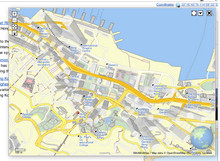Wikipedia:Wikipedia Signpost/2013-02-18/Technology report
Better templates and 3D buildings
Twenty wikis get Lua, more deployments
As of time of writing, twenty wikis (including the English, French and Hungarian Wikipedias) are in the process of getting access to the Lua scripting language, an optional substitute for the clunky template code that exists at present.
The deployments were announced on 15 February for 18 February (wikitech-l mailing list); consequently, most wikis are yet to decide upon policies towards template refactoring. Arguments in favour of a swift implementation cite the proven ability of Lua to reduce like-for-like rendering times (particularly on longer pages) when applied to heavily used templates. The language also allows more complex templates to be created and improves code readability. Arguments in favour of a more cautious approach centre on the propensity for templates to become ever more complex, obscuring their methods to the average user.
The CodeEditor extension is also being deployed, providing Lua developers with a range of proper debugging tools; both it and the Scribunto extension (which provides the basic Lua functionality) have been in testing for several months following initial demos at the 2012 Berlin Hackathon and Wikimania 2012. Lua scripts will be written in a new Module: namespace, being invoked (probably from the Template: namespace, though potentially directly) via a new #invoke: parser function.

The WikiMiniAtlas is a built-in mapping gadget hidden behind the ![]() icon, that shows up on all articles with geographic coordinates attached. Overlaid on a basemap derived from OpenStreetMap data the WikiMiniAtlas (WMA) displays links to geocoded Wikipedia articles and Commons image thumbnails. It features a user interface that is translated into dozens of languages and can display coordinates from over 70 Wikimedia projects.
icon, that shows up on all articles with geographic coordinates attached. Overlaid on a basemap derived from OpenStreetMap data the WikiMiniAtlas (WMA) displays links to geocoded Wikipedia articles and Commons image thumbnails. It features a user interface that is translated into dozens of languages and can display coordinates from over 70 Wikimedia projects.
The latest feature in WikiMiniAtlas is solid 3D buildings at high zoom levels; examples include the Petronas Towers, Burj Khalifa, the Empire State Building and many more. This feature requires a browser with WebGL support (all modern browsers except Internet Explorer). For modern Internet Explorer a wireframe view acts as a fallback. For browsers that do not support the canvas element (older Internet Explorer versions and obsolete browsers) no buildings are shown (it should degrade gracefully). Building geometries are extracted from open source data released by the OpenStreetMap project.
In list articles such as the List of volcanoes in the United States all coordinates from the page are highlighted with blue dots on the map, with the dots being clickable to navigate the list (example). The WikiMiniAtlas also displays OSM object outlines through the WIWOSM project and embedded KML data. Thus the Navajo Nation article (video) is an example of the former and Mojave Desert is an example of the latter. Arbitrary outlines can be dragged across the map to allow for size comparisons; an example of such a comparison is that between Texas and the Democratic Republic of the Congo (video). And of course WikiMiniAtlas goes beyond earth, showing globes of the Moon, Mercury, Mars, Titan, Io, and Venus (example).
In brief
Not all fixes may have gone live to WMF sites at the time of writing; some may not be scheduled to go live for several weeks.
- Third time lucky for English Wikipedia Wikidata deployment: On the third attempt, the Wikidata client was successfully rolled out to the English Wikipedia, with a date in early March now set for all remaining Wikipedias. Although most language links can now be safely removed from any project with the Wikidata client installed, not all can be; users unsure of which links fall into which category are advised to avoid removing any links. Please see Wikipedia:Wikidata for more information.


Discuss this story